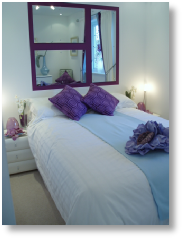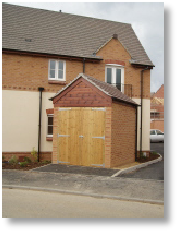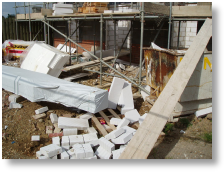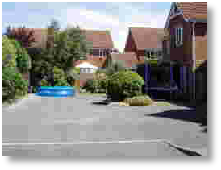Is the site tidy
A tidy site is a good indication that the site manager is in control. It also serves to demonstrate that the tradesmen building your home have a pride in what they do and a commitment to quality. A tidy site is your best indication that your home will be built to a good standard. An unsecured, untidy site, with unstacked materials and uncovered timber is best avoided.
Location
A west facing rear garden will sell for a premium when the time comes. Avoid shared driveways. (see below). Some homes are built facing down the estate road which mean that car headlights will shine into your home. Be aware of other plots that are near road bends, junctions or speed bumps. These often mean additional noise from cars slowing down and speeding up. Avoid properties near the site compound area. The compound is usually the last area to be built on and therefore adjacent properties will suffer the longest disruption in terms of traffic, noise, dust and mud.
Apartments
With apartment blocks, it is worth considering which floor you would prefer to live on. The ground floor offers ease of access, but could be potentially noisy and less secure. The top floor may have better views, better security, the use of a roof space and will possibly be quieter, but access is more difficult, especially if there is no lift. The intermediate floors have the potential to be the least quiet, however these are usually lower priced. Consider carefully before buying a flat with a front door or bedroom wall located near to either the main entrance door or a lift door, as these may be noisier than other flats. Check out the location of the bin store: in summer you will appreciate being as far away from this as possible.
Shared driveways
If at all possible choose a plot which has its own driveway accessed off an adopted estate road. Builders are very keen to maximise the density of houses on a development by the use of shared driveways. If you don’t want children hitting your car with footballs, arguments about maintenance and parking avoid these like the plague. In the long run this will save you the worry of future maintenance and possible disputes with your neighbours over the shared driveway. If you do buy a home with a shared driveway, make sure that the drive is not tarmac; a modern car’s power steering can break it up in a few months.
It used to be normal and could be taken for granted that any roads, footpaths and public open spaces on new housing developments would be adopted and maintained by the Local Authority on completion of the development. This was done under a Section 38 Agreement. Be sure to check that this is the case; otherwise you will soon discover you are stuck with ongoing annual management charges, typically starting at around £200 to £300 a year, for maintaining these areas.
Parking
Where are the parking spaces or garages. Are they close to your property. Are they easily accessible. Are they likely to be obstructed. Are the parking spaces numbered or secured for property owner’s use only. Is the parking space located under a proposed tree (bad), or street light (good).
The location of visitor parking
It is beneficial if there is a provision for off-road visitors’ parking on the development. It gives your visitors somewhere to park and can provide additional parking for residents keeping the main estates roads clear. However it is advisable to avoid homes adjacent to these lay-by areas.
Is the development on fairly level ground
Developments built on sloping sites can result in your property suffering from temporary flooding during heavy rain. You may have access problems during icy conditions. Your property could be more overlooked from properties built on elevated parts of the site. It can also be more difficult to landscape and maintain a garden on a slope.
Room sizes/Showhomes
It may be difficult to judge the size of rooms if buying 'off plan' if your house type has not yet been built or there are no show homes to view. With the room sizes stated in the sales brochure you can compare these to the rooms of your current property. Be aware that some brochures may state room sizes into alcoves or bay windows, to give the impression the room is larger. Watch out for builder's tricks like using large wall mirrors or glass furniture to make the show home rooms appear larger. One trick some builders adopt is to furnish the show homes with scaled down furniture. For example a double bed can be only 4ft wide, seating to the lounge may also be much smaller and the TV is never displayed. When viewing a show home it is a good idea to take a tape measure with you! Be aware that the show home will have many non-standard fixtures and fittings, to tempt you to pay for expensive optional extras or a superior specification. Granite worktops and laminate floors being examples at the moment. The show homes will have all available lighting left on to give an impression of good natural light. The show homes have the decorations 'freshened-up' at regular intervals and the standard of finish is likely to be much higher than in the house you buy.
Room aspect
Look for a design layout where the kitchen window looks out on to the rear garden. Bathroom windows are also better located at the rear or side of the property. It can be preferable for the TV room to face east, as this will prevent sunlight reflection off the screen during the afternoon or early evening.
Social housing/Affordable housing
Ask yourself honestly whether you would want to live next door to rented social housing. These homes are seldom cared for, as is the case with owner-occupied homes and this could seriously affect your ability to sell when the time comes.
Affordable Housing or Shared Equity
This is where the occupant buys part of the house with the remainder being owned by a Housing Association with the occupant paying rent for this proportion. These tend to be better as the occupier has a financial stake in their home. However, be aware that they could sell their proportion to the Housing Association at to future date and they in turn may decide to rent it out.
Buy to Let
How many houses on the development have been purchased by investors. These are usually rented out on the private rental market. Even though private landlords would be keen to protect their investment by fully vetting their tenants, would you choose to live next door to a rented home with the possibility of new neighbours every six months? Whilst not as undesirable as social housing, this too could affect your ability to sell your home in the future.
Street Lighting positions
Whilst this can provide illumination to the front of your property at night, which may deter possible intruders, some people find the glare of the light even through curtains, difficult to live with.
More to check out when you consider buying a new home…>>>
Return to Top












